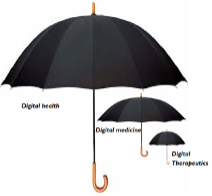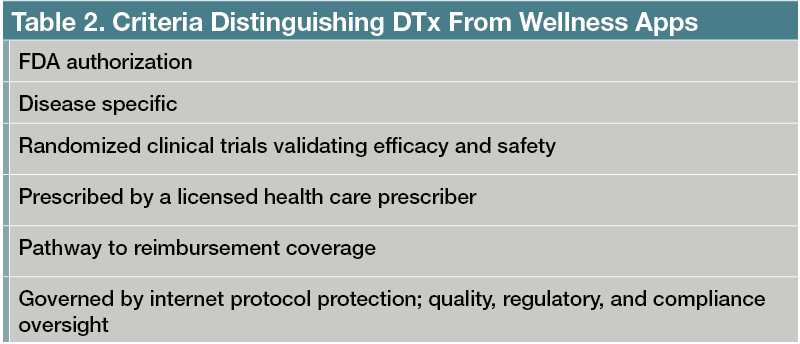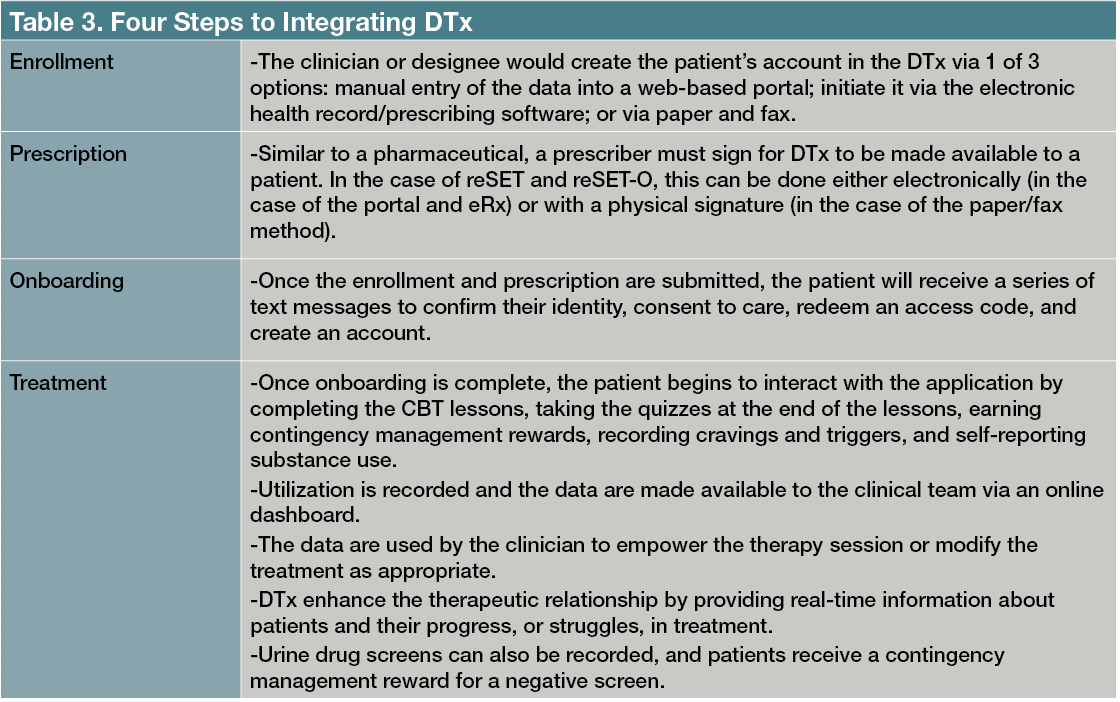Article
Digital Therapeutics for Substance Use Disorders: From Research to Practice
Author(s):
Only a few digital therapeutics are currently FDA approved. What options are available and how can they best be leveraged for the benefit of patients?
stnazkul/AdobeStock

CLINICAL
The concept of digital health dates back to 1995, when Joe Kvedar, MD, pioneered the study of technology’s potential to provide care beyond traditional brick-and-mortar settings. The goal was to expand physicians’ reach by removing barriers such as time, place, and personnel limitations, and also to enhance overall quality of patient care and the patient experience.1 Subsequently, the term e-patient was coined to represent patients who are equipped, enabled, empowered, and engaged in their health care through digital technology.2
Over the last decade, and especially since the COVID-19 pandemic began, technology has been leveraged more than ever in medicine. The umbrella term “digital health” encompasses digital medicine (DM) and refers to all entities that engage lay individuals in wellness and health-related endeavors by collecting data (Figure 1). These generally have no regulatory oversight and are not evidence-based. On the other hand, DM refers to evidence-based digital software or hardware that measures health; it includes such technology as digital diagnostics, biomarker tests, and remote patient-monitoring devices. DMs typically undergo review and have regulatory oversight. Digital therapeutics (DTx), a term referring to products that deliver evidence-based therapeutic interventions to prevent, manage, or treat a condition, are within the DM category. DTx approvals require clinical evidence as well as data on real-world outcomes, and they are reviewed by regulatory bodies for efficacy and safety.
Figure 1. The Digital Health Umbrella

Although several startups have focused on DTx, only 5 developers (Table 1) have received US Federal Drug Administration (FDA) approvals.3 Just 2 of these DTx are directed toward substance use disorders (SUDs): reSET, a 90-day program for treating SUDs; and reSET-O, an 84-day program to treat opioid use disorder (OUD). Both originated with the Therapeutic Education System at Dartmouth Hitchcock Medical Center and were evaluated in studies funded by the National Institutes of Health.4,5 SUDs are currently managed through evidence-based behavioral or psychological modes of management; DTx package these otherwise in-person services (ie, cognitive behavioral therapy [CBT], contingency management) into digital products that are available 24/7. When comparing electronic and in-person treatment, many studies have found equal efficacy, suggesting that FDA-approved DTx will offer attractive treatment options for SUDs for years to come.6
Table 1. Five Currently FDA-Approved DTx

FDA Approval Process and Regulatory Aspects
As with pharmacological agents and medical devices, DTx undergo review and are cleared or approved by the FDA. This requires submission of superiority trial data, either via de novo or the 510(k) pathways. A 510(k) is a premarket submission demonstrating that the device to be marketed is at least as safe and effective as another legally marketed device. The de novo premarket review pathway is a regulatory pathway for low- to moderate-risk devices that are novel, and for products for which there is no legally marketed predicate device with which to claim substantial equivalence. Some DTx undergo randomized controlled trials under the premarket approval process to demonstrate safety and efficacy. As a subset of the DM market, DTx are distinguished from other wellness apps and telehealth offerings by fulfilling several criteria (Table 2).
Table 2. Criteria Distinguishing DTx From Wellness Apps

In terms of regulatory processes, DTx can fall under the heading of either 1) software as a medical device (SaMD), or 2) mobile medical applications (MMAs). The FDA defines SaMD as software that is intended for medical purposes but is not part of a hardware medical device. It defines MMAs as mobile applications that incorporate device software, and that either serve as an accessory to a regulated medical device or transform a medical platform into a regulated medical device.
What Is the Evidence for Efficacy?
reSET-O authorization was based on data from a multisite, controlled, 12-week clinical trial of 170 participants who received supervised buprenorphine treatment paired with a behavioral therapy program, either with or without the addition of reSET-O.7 Participants received supervised administration of buprenorphine and urine screens 3 times per week in a contingency management system that rewarded negative urine tests. reSET-O was not shown to decrease illicit drug use any more than buprenorphine treatment and contingency management alone. However, the data from the same 12-week treatment program also showed a statistically significant increase in retention for the patients who used reSET-O (82.4% retention rate) compared with those who did not (68.4%). No adverse effects were found to be associated with reSET-O use.
It is important to note that the application is not intended for use as a stand-alone therapy or as a substitute for medication. The reSET-O device was reviewed through the 510(k) pathway.
reSET authorization was granted following a multisite, 12-week clinical trial of 399 participants who received either standard treatment or standard treatment with the addition of reSET.8 The data showed a statistically significant increase in adherence to abstinence for the patients with alcohol, cocaine, marijuana, and stimulant addictions who used reSET (40.3%), compared with those who did not (17.6%). Once again, no adverse effects were found to be associated with reSET use.
After receiving approval, 2 additional studies were conducted. The first study reported on a real-world, observational evaluation of 3144 outpatients with OUD who used reSET-O to supplement buprenorphine treatment.9 The results supported the generalizability and real-world impact of reSET-O to a wide variety of patients with OUD beyond the pivotal randomized clinical trial.
The second study examined the impact on health care utilization following reSET implementation.10 In this study, the authors retrospectively analyzed claims 6 months before and after reSET-O implementation for 351 participants with OUD undergoing buprenorphine maintenance treatment (mean age, 37 years; 59.5% female; 82.6% Medicaid). reSET-O use was associated with fewer inpatient, intensive care unit (ICU), emergency department (ED), and other clinical encounters, which resulted in reduced net health care costs over 6 months. Specifically, there were 228 preindex (6 months prior to reSET-O initiation) and 153 post index (6 months post reSET-O initiation) unique hospital-related visits (preindex medication possession, 0.76). This reduction represents a total of 75 unique facility encounters that were avoided, including 45 inpatient hospital stays (4 of which were ICU stays) and 27 ED visits. Overall, there were approximately 1181 fewer claims post index, with a corresponding $2150 projected reduction in health care spending for each patient treated with reSET-O, based on the 2020 CMS fee schedule.
How DTx Work
DTx are applications that turn a mobile device into a therapeutic delivery platform. DTx are installed on the patient’s smartphone or tablet and allow the patient to learn about their disease, enter real-time data, and experience patient-facing interventions. The patient’s progress and entries in the application are then monitored by the clinician via a web-based portal, and this information is used to improve the treatment. The personal information divulged by the patient is clinically relevant, and only the clinical team has access to it (Figure 2).
Figure 2. Patient Path Through DTx

DTx have several advantages: They allow patients to move through treatment at their own pace, offer reduced cost, enhance treatment engagement through 24/7 availability, reduce therapist intervention time, and reduce stigma because treatment can be done privately (Table 3). All patients at any stage in their recovery, and regardless of their placement along the motivational spectrum, can participate. Interestingly, 89% of patients used reSET and reSET-O at least once during nonclinical hours.11
Table 3. Four Steps to Integrating DTx

reSET-O and reSET (collectively reSET-O) deliver a form of evidence-based neurobehavioral therapy founded on the community reinforcement approach (CRA), an intensive addiction-specific form of CBT validated for OUD.12 CRA derives from the notion that psychoactive agents compete with more delayed psychosocial reinforcers; therefore, treatment teaches patients to increase satisfaction with drug-free sources of reinforcement.13 reSET-O content consists of a series of 67 interactive on-demand audio, text, and video CRA modules sequentially unlocked as patients progress through the therapy. Each module delivers 30 minutes of treatment; patients are expected to complete 4 per week, with the ability to revisit any module. Comprehension of, and proficiency with, therapeutic content is supported by a neurobehavioral approach known as fluency training that uses a quiz format to reinforce understanding of positive adaptive behaviors immediately following each lesson. Contingency management, a highly effective evidence-based approach for OUD treatment, follows each lesson to immediately recognize and reward patients’ engagement with treatment.
Concluding Thoughts
Although to date few DTx options exist, and only 2 are FDA approved for patients with SUDs, the evidence base is quite promising. The FDA recently generated a process to approve prescription DTx, and as such we should see more of them emerging. Based on reported patient outcomes and cost savings to the system, broad insurance coverage should follow, removing more barriers to implementation. As clinicians, we need to be aware of the available DTx and how to best leverage them for the benefit of our patients.
Dr Stanciu is assistant professor of psychiatry at Dartmouth University’s Geisel School of Medicine and director of addiction services at New Hampshire Hospital. He is Addiction Section Editorfor Psychiatric TimesTM.
References
1. Dang A, Arora D, Rane P. Role of digital therapeutics and the changing future of healthcare. J Family Med Prim Care. 2020;9(5):2207-2213.
2. Fox S. The engaged e-patient population. Pew Research Center. August 26, 2008. Accessed June 24, 2021. https://www.pewresearch.org/internet/2008/08/26/the-engaged-e-patient-population/
3. Prescription digital therapeutics pipeline of pipelines. Exits & Outcomes. June 11, 2021. Accessed July 6, 2021. https://exitsandoutcomes.com/prescription-digital-therapeutics-pipeline-of-pipelines/
4. Campbell ANC, Nunes EV, Matthews AG, et al. Internet-delivered treatment for substance abuse: a multisite randomized controlled trial. Am J Psychiatry. 2014;171(6):683-690.
5. Christensen DR, Landes RD, Jackson L, et al. Adding an Internet-delivered treatment to an efficacious treatment package for opioid dependence. J Consult Clin Psychol. 2014;82(6):964-972.
6. Luo C, Sanger N, Singhal N, et al. A comparison of electronically-delivered and face to face cognitive behavioural therapies in depressive disorders: a systematic review and meta-analysis. EClinicalMedicine. 2020;24:100442.
7. Maricich YA, Bickel WK, Marsch LA, et al. Safety and efficacy of a prescription digital therapeutic as an adjunct to buprenorphine for treatment of opioid use disorder. Curr Med Res Opin. 2021;37(2):167-173.
8. Web-delivery of evidence-based, psychosocial treatment for substance use disorders (CTN-0044). ClinicalTrials.gov. Updated July 11, 2017. Accessed June 30, 2021 https://clinicaltrials.gov/ct2/show/NCT01104805
9. Maricich YA, Xiong X, Gerwien R, et al. Real-world evidence for a prescription digital therapeutic to treat opioid use disorder. Curr Med Res Opin. 2021;37(2):175-183.
10. Velez FF, Colman S, Kauffman L, et al. Real-world reduction in healthcare resource utilization following treatment of opioid use disorder with reSET-O, a novel prescription digital therapeutic. Expert Rev Pharmacoecon Outcomes Res. 2021;21(1):69-76.
11. Our treatments. Reset for Recovery. Accessed July 6, 2021. https://www.resetforrecovery.com/patient/our-treatments/
12. Marsch LA, Guarino H, Acosta M, et al. Web-based behavioral treatment for substance use disorders as a partial replacement of standard methadone maintenance treatment. J Subst Abuse Treat. 2014;46(1):43-51.
13. Budney AJ, Higgins ST. A community reinforcement plus vouchers approach: treating cocaine addiction. US Department of Health & Human Services, National Institutes of Health. April 1998. Accessed June 24, 2021. https://archives.drugabuse.gov/sites/default/files/cra.pdf






